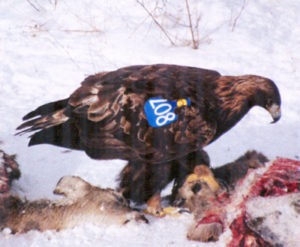
By Michael Howell
The Raptor View Research Institute (RVRI), the Bitterroot Audubon Society and the Bitterroot Land Trust are teaming up to help develop a Citizen Science network of camera stations and eagle capture sites on private, working lands throughout the Bitterroot Valley during the winter of 2016-2017. They hope to raise funds to deploy two satellite transmitters on adult Golden Eagles.
The research institute has been studying overwintering eagles here since 2011. To date, according to Kate Stone, director of the institute, they have captured over 70 Golden Eagles and 19 or 20 Bald Eagles. The captured birds get wing tags, numbered leg bands and some satellite transmitters depending on species and age.
All the eagles have been captured on private property on the MPG Ranch at the north end of the valley. This site attracts a limited portion of the overwintering population using the valley, and over time, eagles have learned to avoid the carcasses at the capture station. Now RVRI researchers would like to expand the extent of the study to private lands in other parts of the valley.
Stone said that in agricultural valleys like the Bitterroot, our working lands and their stewards are often underappreciated for the habitat services they provide to all community members.
“We hope to work towards bridging that gap,” said Stone. She said part of the project involves producing an interactive map on the internet showing migration paths in the valley.
Stone said that getting insights into the bird’s behavior was important, especially with populations of Golden Eagles in decline.
“Preserving open, agricultural land provides more than a good view,” said Stone, “it provides incredible habitat for raptors.” Stone said that they have already set up a dozen carcass stations and have about 15 more in the works.
Another plan is to crowd source the 50,000 photos already collected at wildlife camera stations in the valley on Zooiverse and have the public help in making identifications.
“We see everything from eagles to owls to coyotes, foxes and mountain lions,” said Stone.
Stone said that eagles in the Bitteroot generally migrate northward to Canada and Alaska, “but they return annually to the Bitterroot with great fidelity.” While here they roam the entire valley and may even take trips outside the valley over the course of the winter. RVRI already has an unusually high re-sighting rate for its marked eagles, partially due to the use of motion-sensing cameras by private citizens, she said.
The study area has been divided into nine sections. The goal is to have one camera trap active in each section at all times of the winter, from early December through March.
“We anticipate leaving camera traps at each location for approximately two weeks. We will check the status of the carcasses and camera performance weekly, though we may change this time frame depending on activity,” said Stone.
Project leaders and volunteers will be trained to standardize carcass and camera placement. Carcasses will be staked in place to prevent movement. Volunteers will upload images to the crowd sourcing site for identification. Anyone can keep track of the imagery coming in, and participate in the identification of animals caught on camera. Camera locations will not be disclosed to the public. All the trapping will be done by permitted professionals.
People can help by allowing access for a carcass station, talking to friends and neighbors about land access, setting and maintaining carcass and camera stations, observing eagle behavior at carcass sites, helping to process collected images, or donating towards equipment purchases. Prizes will be awarded to any landowner who has a marked eagle appear on his/her property, or to the person contributing the most to image processing.
A Pint Night to benefit the project is scheduled at the Stevensville Cafe on Thursday, January 26 from 5:30 to 8 p.m. For more information contact Kate Stone at 381-1115 or email kstone@mpgranch.com or call Eric Rasmussen at 612-590-5121 or email him at erasmussen@mpgranch.com.
